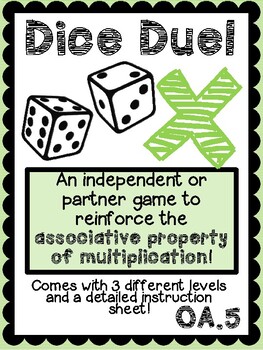Associative Property of Multiplication Game - Dice Duel! (Leveled)
beachingandteaching
293 Followers
Grade Levels
3rd - 5th
Subjects
Resource Type
Standards
CCSS3.OA.B.5
CCSS5.OA.A.1
Formats Included
- PDF
Pages
7 pages
beachingandteaching
293 Followers
What educators are saying
My students loved playing the dice game. It was a fun way to practice the associative property of multiplication.
My students loved this so much! They had no idea that they were learning and retaining the associative property! Thank you so much for creating this!
Description
This is a game that can be played in one lesson. It can be independent or with a partner. It reinforces the concept of the associative property of multiplication.
Students roll three dice. They then create an equation to solve that makes the most number sense.
My students love it, and it really teaches the reasoning behind this property.
There are three levels: below grade level, on, and above.
Have fun!
Total Pages
7 pages
Answer Key
N/A
Teaching Duration
30 minutes
Report this resource to TPT
Reported resources will be reviewed by our team. Report this resource to let us know if this resource violates TPT’s content guidelines.
Standards
to see state-specific standards (only available in the US).
CCSS3.OA.B.5
Apply properties of operations as strategies to multiply and divide. Examples: If 6 × 4 = 24 is known, then 4 × 6 = 24 is also known. (Commutative property of multiplication.) 3 × 5 × 2 can be found by 3 × 5 = 15, then 15 × 2 = 30, or by 5 × 2 = 10, then 3 × 10 = 30. (Associative property of multiplication.) Knowing that 8 × 5 = 40 and 8 × 2 = 16, one can find 8 × 7 as 8 × (5 + 2) = (8 × 5) + (8 × 2) = 40 + 16 = 56. (Distributive property.)
CCSS5.OA.A.1
Use parentheses, brackets, or braces in numerical expressions, and evaluate expressions with these symbols.





